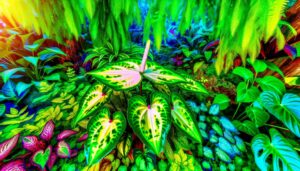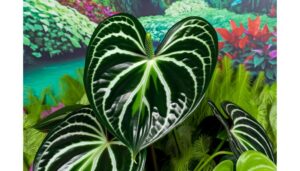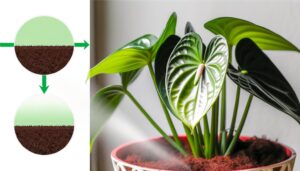7 Key Differences Between Anthurium Pallidiflorum Vs Vittarifolium
Anthurium pallidiflorum and Anthurium vittarifolium have distinct botanical features and ecological preferences. A.
pallidiflorum has lanceolate, glossy leaves with parallel venation, while A. vittarifolium showcases strap-shaped, matte leaves with reticulate venation.
The former exhibits climbing growth with aerial roots, whereas the latter is a trailing plant with elongated stems. A.
pallidiflorum holds its leaves upright, optimizing vertical habitats, contrasting with the horizontally sprawling foliage of A. vittarifolium.
Additionally, A. pallidiflorum blooms sporadically with lanceolate petals, unlike A.
vittarifolium’s seasonal, ovate-petaled flowers. Both require humid environments and diffused light but differ in spatial and structural adaptations.
Learn more about their unique care needs.

Differences between Anthurium Pallidiflorum & Anthurium Vittarifolium:
| Feature | Anthurium Pallidiflorum | Anthurium Vittarifolium |
|---|---|---|
| Leaf Shape and Size | Long, narrow, lance-shaped leaves | Elongated, strap-like leaves |
| Leaf Texture | Velvety texture | Leathery texture |
| Leaf Color | Dark green with a slightly metallic sheen | Bright green with a matte finish |
| Growth Habit | Climbing or trailing habit | Trailing habit |
| Inflorescence | Small, greenish spathes and spadices | Larger, reddish or green spathes and spadices |
| Light Requirements | Prefers bright, indirect light | Can tolerate lower light levels |
| Watering Needs | Requires consistent moisture | Less frequent watering, more drought-tolerant |
Key Takeaways
- Anthurium pallidiflorum has glossy, lanceolate leaves, while Anthurium vittarifolium has matte, strap-shaped leaves.
- Anthurium pallidiflorum exhibits climbing growth, whereas Anthurium vittarifolium has a trailing growth habit.
- Leaf positioning in Anthurium pallidiflorum is upright, while Anthurium vittarifolium’s leaves are horizontally sprawling or pendulous.
- Anthurium pallidiflorum blooms sporadically with lanceolate petals, contrasting Anthurium vittarifolium’s seasonal flowering with ovate petals.
- Anthurium pallidiflorum prefers bright, indirect light, while Anthurium vittarifolium thrives in similar light conditions but with different spatial needs.
Leaf Shape and Size
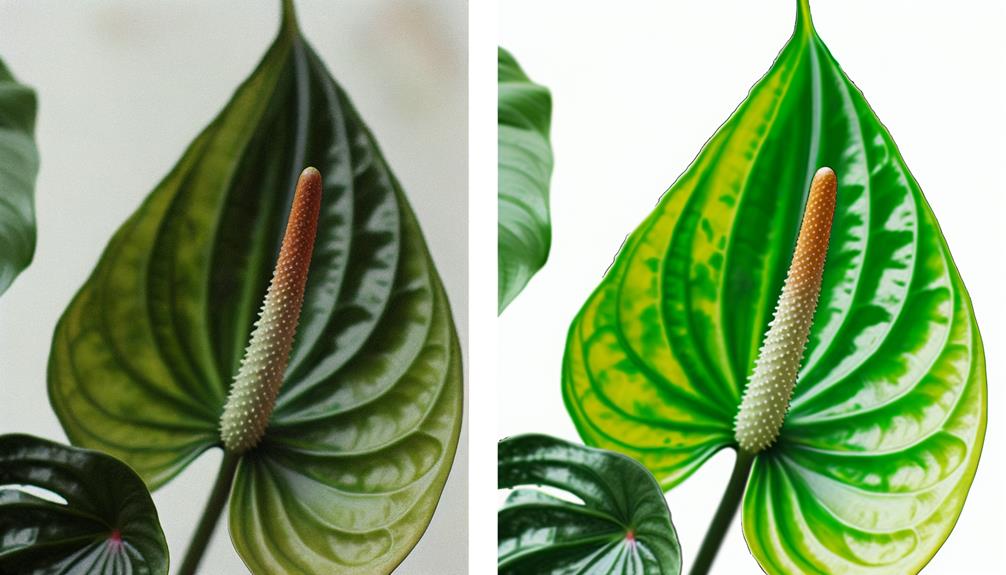
The leaf morphology of Anthurium pallidiflorum and Anthurium vittarifolium exhibits distinct differences, primarily regarding shape, size, and venation patterns.
Anthurium pallidiflorum features elongated, lanceolate leaves, often reaching lengths of up to 90 cm, with a width rarely exceeding 10 cm. The leaves possess a smooth, glossy surface and exhibit prominent, parallel venation.
In contrast, Anthurium vittarifolium displays broader, strap-shaped leaves that can extend to 1.2 meters in length and 15 cm in width. These leaves are characterized by a matte texture and a more reticulate venation pattern.
Such morphological distinctions are significant for accurate identification and understanding of the species’ adaptive strategies within their respective ecological niches.
Growth Habit
Anthurium pallidiflorum exhibits a climbing growth habit characterized by its epiphytic nature, attaching to vertical surfaces and ascending through its aerial roots.
In contrast, Anthurium vittarifolium demonstrates a trailing growth habit, with elongated stems that cascade downward, often forming a dense mat.
These differing growth patterns result in distinct spatial requirements and leaf position variations, with A. pallidiflorum favoring upward growth and A. vittarifolium spreading horizontally.
Climbing Vs. Trailing Habit
Distinct growth habits characterize Anthurium pallidiflorum as a climber and Anthurium vittarifolium as a trailer, greatly influencing their ecological adaptations and cultivation requirements.
Anthurium pallidiflorum exhibits scandent growth, utilizing aerial roots to ascend vertical supports, which optimizes light capture and positions it advantageously within the forest canopy.
In contrast, Anthurium vittarifolium demonstrates a pendent growth form, with stems that drape over substrates, facilitating efficient nutrient absorption from detritus-laden surfaces.
These divergent growth strategies necessitate distinct horticultural practices: climbers benefit from structures that support vertical growth, while trailers thrive in conditions that allow for horizontal expansion.
Understanding these growth habits is essential for successful cultivation and highlights the evolutionary adaptations that distinguish these species within the Araceae family.
Leaf Position Variations
While dissecting the leaf position variations between Anthurium pallidiflorum and Anthurium vittarifolium, one must note the former’s upright, vertical orientation compared to the latter’s horizontally sprawling or pendulous foliage.
Anthurium pallidiflorum exhibits a robust, erect leaf posture, which contributes to its structural rigidity and maximizes light capture in vertically constrained environments.
Conversely, Anthurium vittarifolium’s leaves exhibit a more lax, pendulous arrangement, often draping gracefully from elevated positions, optimizing its adaptation to horizontally expansive or hanging habitats.
This distinct leaf positioning in A. vittarifolium facilitates efficient light interception over a broader spatial plane, thereby enhancing photosynthetic efficiency in its native understory environment.
These variations underscore the species-specific ecological strategies and adaptive morphologies within the Anthurium genus.
Space Requirements
The spatial requirements of Anthurium pallidiflorum and Anthurium vittarifolium are intrinsically linked to their growth habits, which dictate their suitability for varying cultivation environments.
Anthurium pallidiflorum exhibits a more compact growth habit, with elongated, strap-like leaves that reach up to 90 cm in length. This species prefers a vertical orientation, necessitating moderate horizontal space but significant vertical clearance.
In contrast, Anthurium vittarifolium displays a sprawling growth habit, characterized by its pendent, lanceolate leaves, which can extend up to 150 cm. This species requires ample horizontal space to accommodate its cascading foliage.
Both species thrive under similar environmental conditions but necessitate different spatial configurations to optimize their growth, making precise spatial planning essential for successful cultivation.
Flower Structure
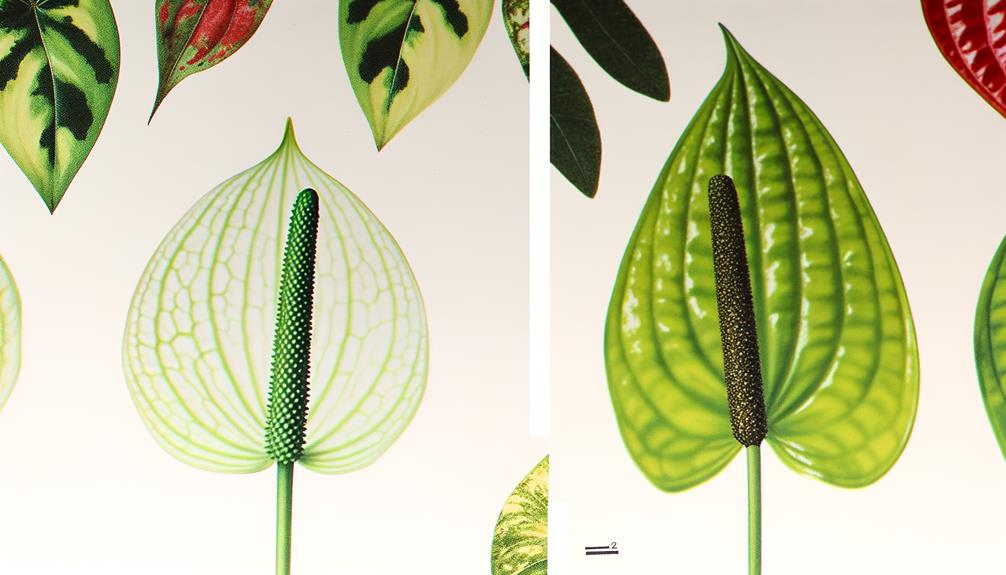
The flower structure of Anthurium Pallidiflorum and Anthurium Vittarifolium exhibits significant variations, particularly in petal morphology and blooming patterns.
Anthurium Pallidiflorum features elongated, lanceolate petals, whereas Anthurium Vittarifolium presents more ovate, broader petals.
Additionally, their blooming cycles differ, with Pallidiflorum producing inflorescences sporadically throughout the year, while Vittarifolium follows a more seasonal flowering schedule.
Petal Shape Comparison
Anthurium pallidiflorum exhibits a more elongated and narrow petal structure compared to the broader and more ovate petals of Anthurium vittarifolium. The petal morphology noticeably influences the overall aesthetic and function of each species.
- Elongated Structure: Anthurium pallidiflorum’s petals are characterized by their slender, linear form, which contributes to a refined, elegant appearance.
- Ovate Form: Anthurium vittarifolium features petals that are wider and more rounded, offering a robust and fuller visual impact.
- Surface Texture: The petal surfaces of A. pallidiflorum tend to be smoother and glossier, whereas A. vittarifolium’s petals may display a more pronounced veining pattern.
Understanding these distinctions aids in the precise identification and appreciation of each species’ unique floral architecture.
Blooming Patterns Differentiation
In addition to the distinct petal shapes, the blooming patterns of Anthurium pallidiflorum and Anthurium vittarifolium exhibit significant differences in their inflorescence structure and flowering cycles.
Anthurium pallidiflorum produces a spadix that is remarkably elongated and slender, accompanied by a spathe that tends to be more inconspicuous and greenish.
In contrast, Anthurium vittarifolium features a thicker, more robust spadix with a spathe that is often broader and shows a more pronounced coloration.
The flowering cycle of A. pallidiflorum is relatively shorter, with blooms appearing more frequently but lasting for a brief period.
Conversely, A. vittarifolium has a longer flowering cycle, with blooms that are less frequent but persist for an extended duration, enhancing their ornamental value.
Natural Habitat
Native to the humid rainforests of Ecuador, both Anthurium pallidiflorum and Vittarifolium thrive in distinct microclimates that favor high humidity and consistent moisture.
These plants exhibit a preference for the understory of tropical forests where light is diffused, and the environment remains cool and damp.
The unique ecological niches they occupy are characterized by:
- High Humidity: Regularly exceeding 80%, this moisture-rich environment is essential for their best growth.
- Consistent Moisture: The frequent rainfall and abundant leaf litter create a consistently moist substrate.
- Temperature Stability: Year-round temperatures typically range between 18-25°C, ensuring minimal thermal stress.
Understanding these habitat requirements is necessary for replicating conditions conducive to their growth and survival in cultivation.
Light Requirements
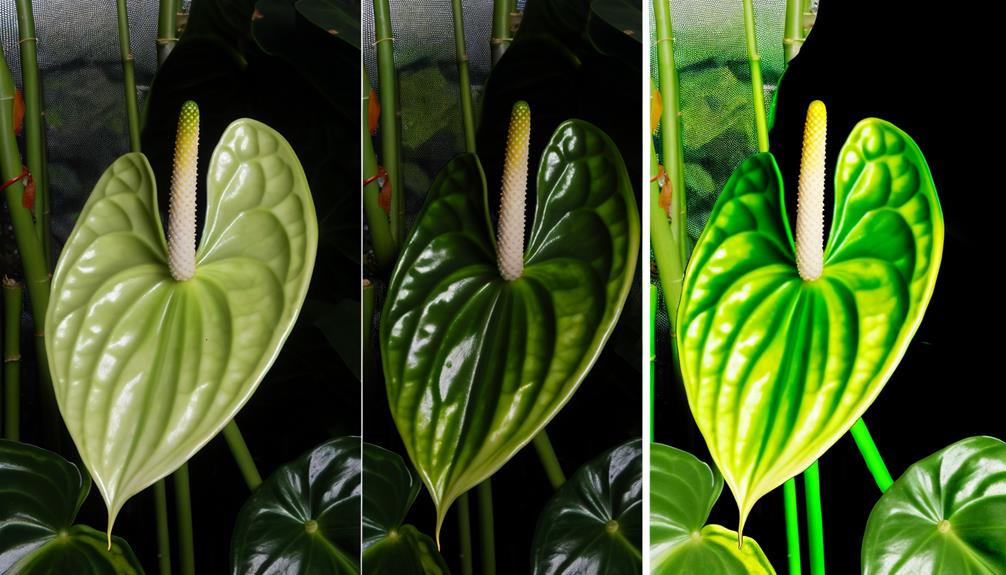
Given their origins in the understory of tropical forests, both Anthurium pallidiflorum and Vittarifolium exhibit specific light requirements that replicate the diffused and filtered sunlight characteristic of their natural habitat.
Anthurium pallidiflorum thrives under bright, indirect light, avoiding direct sun exposure which can lead to photodamage and chlorosis.
Similarly, Anthurium vittarifolium prefers a shaded environment with dappled light, mimicking the canopy cover of its endemic regions.
Ideal light conditions for these species involve placing them in well-lit areas with protection from direct sunlight, such as behind sheer curtains or in shaded greenhouse sections.
Utilizing artificial grow lights with a spectrum range of 4000-6000K can further optimize adequate photosynthetic radiation without the risk of excessive light stress.
Watering Needs
Both Anthurium pallidiflorum and Vittarifolium necessitate a meticulously balanced watering regimen to prevent root rot while ensuring adequate hydration, as their epiphytic nature predisposes them to specific moisture requirements.
These tropical species thrive under conditions of consistent humidity and well-draining substrates.
Overwatering can lead to anoxic root conditions, promoting pathogenic infections. Conversely, underwatering may result in desiccation and nutrient uptake inhibition.
To evoke emotion, consider the following key points:
- Overwatering pitfalls: Root rot and fungal proliferation.
- Underwatering hazards: Leaf curling and wilting.
- Optimal conditions: Moist, yet aerated soil resembling their natural habitat.
Temperature Tolerance
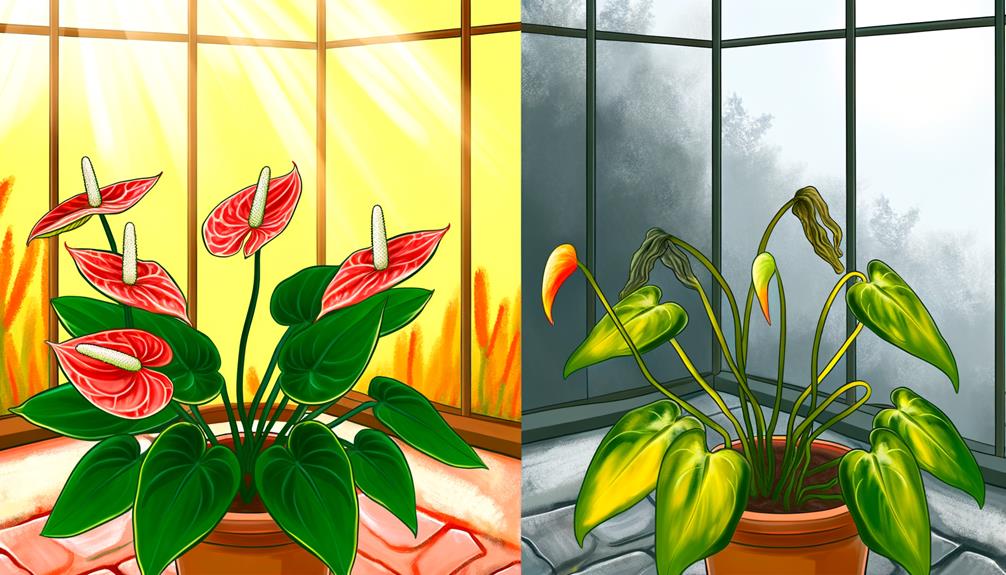
Maintaining the appropriate temperature for Anthurium pallidiflorum and Vittarifolium is vital, as these species require a stable, warm environment to mimic their native tropical habitats and support peak physiological functioning.
Both species thrive in temperatures ranging from 65°F to 80°F (18°C to 27°C). However, they display varying degrees of cold tolerance and adaptability to temperature fluctuations.
| Feature | Anthurium pallidiflorum | Anthurium vittarifolium |
|---|---|---|
| Best Temperature | 65-80°F (18-27°C) | 65-80°F (18-27°C) |
| Cold Tolerance | Moderate | Low |
| Heat Tolerance | High | Moderate |
| Temperature Fluctuation | Less Tolerant | More Tolerant |
| Ideal Night Temp | 60-65°F (15-18°C) | 60-65°F (15-18°C) |
Understanding these temperature requirements ensures the best growth and minimizes stress-induced physiological disorders.
Anthurium Wendlingeri Vs Pallidiflorum
Here’s a comparison table for Anthurium wendlingeri and Anthurium pallidiflorum:
| Feature | Anthurium Wendlingeri | Anthurium Pallidiflorum |
|---|---|---|
| Origin | Central America | South America |
| Habitat | Rainforests | Tropical rainforests |
| Leaf Shape | Long, spiraling leaves | Long, narrow, pendulous leaves |
| Leaf Texture | Smooth with prominent veining | Smooth with subtle veining |
| Growth Habit | Climbing | Climbing |
| Flower Spathe | Less prominent, greenish | Not very prominent, greenish |
| Flower Spadix | Long, tapering | Long, straight |
| Ideal Temperature | Warm, humid (65-80°F) | Warm, humid (65-80°F) |
| Soil Type | Well-draining, rich in organic matter | Well-draining, rich in organic matter |
| Watering Needs | Moderate, consistent moisture | Moderate, consistent moisture |
| Light Requirements | Bright, indirect light | Bright, indirect light |
| Common Uses | Ornamental indoor plants | Ornamental indoor plants |
| Propagation | Stem cuttings, air layering | Stem cuttings, air layering |
Conclusion
The comparative analysis of Anthurium pallidiflorum and Anthurium vittarifolium reveals critical distinctions in leaf morphology, growth patterns, reproductive structures, ecological niches, photic demands, hydration preferences, and thermal resilience.
Significantly, A. pallidiflorum exhibits elongated, lanceolate leaves that can exceed 1 meter in length, underscoring its adaptation to specific microhabitats.
Such detailed botanical differentiation aids in targeted conservation strategies and horticultural practices, enhancing understanding of species-specific needs and contributing to the preservation of biodiversity within the Anthurium genus.

